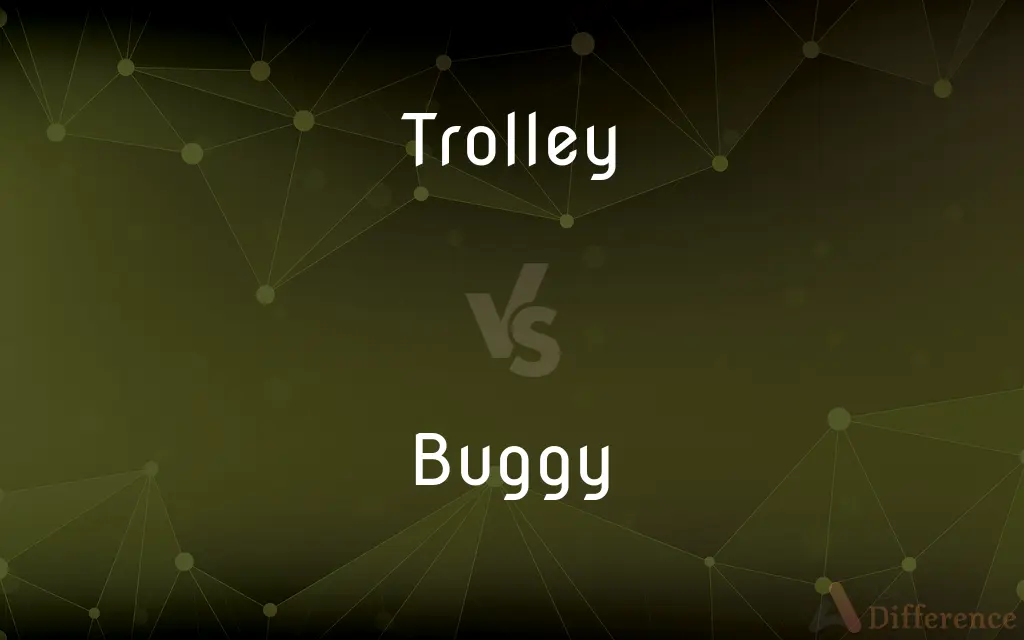Trolley vs. Buggy — What's the Difference?
Edited by Tayyaba Rehman — By Maham Liaqat — Updated on April 24, 2024
A trolley is a wheeled vehicle for transporting goods or passengers, often running on rails, whereas a buggy refers to a lightweight carriage with four wheels, typically pulled by horses.

Difference Between Trolley and Buggy
Table of Contents
ADVERTISEMENT
Key Differences
A trolley is usually associated with urban public transportation systems where it operates on rails or is powered electrically through overhead cables. On the other hand, a buggy is a traditional vehicle used for personal transport, often seen in rural or historic settings, and is commonly horse-drawn.
Trolleys are integral to mass transit in cities and can accommodate a large number of passengers, contributing to urban commuting efficiency. Whereas, buggies are more personal or recreational, offering a quaint, leisurely way to travel, especially appealing in scenic or tourist areas.
The design of a trolley is built for durability and continuous use, equipped with hard seating, large capacity, and robust construction. In contrast, buggies are designed for comfort and aesthetic appeal, often featuring open tops, comfortable seating, and a lightweight frame for easy maneuverability.
Trolleys are powered by electricity, making them an environmentally friendly option in urban centers. Buggies, however, rely on animal power, specifically horses, which requires different considerations such as animal welfare and speed limitations.
The operation of trolleys is typically regulated by public transportation authorities, ensuring safety and scheduled services. Buggies, on the other hand, can be privately owned and operated, giving owners more flexibility but less regulatory oversight.
ADVERTISEMENT
Comparison Chart
Primary Use
Public transport
Personal or recreational transport
Power Source
Electric motors, often with overhead cables
Horse-drawn
Capacity
Large, designed to carry multiple passengers
Smaller, typically carries 2-4 people
Environment
Urban settings
Rural or historic settings
Regulatory Body
Public transportation authorities
Less regulation, often privately operated
Compare with Definitions
Trolley
An overhead rail or wire from which a trolley is suspended or powered.
The repair crew worked on the trolley wire to restore the electric bus service.
Buggy
A light, four-wheeled horse-drawn carriage.
They rented a buggy to explore the countryside roads.
Trolley
A small table on wheels used for serving drinks or meals.
The waiter wheeled in a trolley laden with desserts.
Buggy
An open, wheeled vehicle for off-road travel, often motorized.
They drove the dune buggy across the sandy beach.
Trolley
A vehicle that runs on tracks and is typically powered by electricity.
The trolley clanged down the city street, its bell alerting pedestrians.
Buggy
A software term for an error or flaw.
The program was buggy, causing it to crash frequently.
Trolley
A wheeled frame or basket used in supermarkets or airports.
She pushed her trolley through the grocery aisles, filling it with food and supplies.
Buggy
A baby carriage or stroller.
She gently placed her newborn in the buggy for a walk in the park.
Trolley
A wheeled device used in workshops or industries to transport heavy objects.
He used a trolley to move the boxed products across the warehouse.
Buggy
Referring to something infested with bugs.
The old shed was buggy, filled with spiders and insects.
Trolley
A large metal basket or frame on wheels, used for transporting heavy or large items, such as supermarket purchases or luggage at an airport or railway station.
Buggy
A small motor vehicle, typically with an open top
A golf buggy
Trolley
A wheel attached to a pole, used for collecting current from an overhead electric wire to drive a tram.
Buggy
A light folding chair on wheels, in which a baby or young child can be pushed along
Her two younger children were in a buggy
Trolley
Short for trolleybus or trolley car
Buggy
Infested with bugs.
Trolley
A streetcar.
Buggy
(of a computer program or system) faulty in operation.
Trolley
A device that collects electric current from an underground conductor, an overhead wire, or a third rail and transmits it to the motor of an electric vehicle.
Buggy
Mad; insane.
Trolley
A small truck or car operating on a track and used in a mine, quarry, or factory for conveying materials.
Buggy
A small, light, one-horse carriage usually having four wheels in the United States and two wheels in Great Britain.
Trolley
A wheeled carriage, cage, or basket that is suspended from and travels on an overhead track.
Buggy
A baby carriage.
Trolley
Chiefly British A light cart designed to be moved by hand.
Buggy
A passenger or recreational vehicle, usually with oversized tires, designed for off-road use.
Trolley
To convey (passengers) or travel by trolley.
Buggy
(Informal) An automobile.
Trolley
A trolley pole; a single-pole device for collecting electrical current from an overhead electrical line, normally for a tram/streetcar or a trolleybus.
Buggy
Chiefly Southern US A shopping cart, especially for groceries.
Trolley
(US) A streetcar or light train.
Buggy
Infested with bugs.
Trolley
A light rail, tramway, trolleybus or streetcar system.
Buggy
(Computers) Having many software bugs
A buggy program.
Trolley
A truck from which the load is suspended in some kinds of cranes.
Buggy
(Slang) Crazy.
Trolley
A truck which travels along the fixed conductors in an electric railway, and forms a means of connection between them and a railway car.
Buggy
A small horse-drawn cart.
Trolley
A cart or shopping cart; a shopping trolley.
Buggy
A small motor vehicle, such as a dune buggy.
Trolley
(British) A hand truck.
Buggy
A hearse.
Trolley
(British) A soapbox car.
Buggy
A pushchair; a stroller.
Trolley
(British) A gurney, a stretcher with wheeled legs.
Buggy
A shopping cart or trolley.
Trolley
(Philippines) A handcar.
Buggy
With insects.
Trolley
To bring to by trolley.
Buggy
(computing) Containing programming errors.
This software is so buggy that I don't know how anyone can use it!
Trolley
To use a trolley vehicle to go from one place to another.
Buggy
Resembling an insect.
Trolley
To travel by trolley (streetcar, trolleybus or light train).
Buggy
(slang) crazy; bughouse.
Trolley
A form of truck which can be tilted, for carrying railroad materials, or the like.
Buggy
Infested or abounding with bugs.
Trolley
A wheeled vehicle that runs on rails and is propelled by electricity;
`tram' and `tramcar' are British terms
Buggy
A light one horse two-wheeled vehicle.
Villebeck prevailed upon Flora to drive with him to the race in a buggy.
Buggy
A light, four-wheeled vehicle, usually with one seat, and with or without a calash top.
Buggy
A small lightweight carriage; drawn by a single horse
Buggy
Informal or slang terms for mentally irregular;
It used to drive my husband balmy
Buggy
Infested with bugs
Common Curiosities
What is the main purpose of a trolley?
A trolley is primarily used in public transportation systems to carry multiple passengers across urban routes.
Can a trolley be used for personal transport?
Trolleys are generally not used for personal transport as they are part of scheduled public transit systems.
What is the typical passenger capacity of a buggy?
A typical buggy can carry about two to four passengers, depending on its size and design.
Do trolleys contribute to environmental sustainability?
Yes, trolleys are considered environmentally friendly as they mostly run on electricity and reduce the number of individual vehicles on the road.
What kind of maintenance does a buggy require?
Buggy maintenance includes care for the horse, as well as the vehicle’s wheels, frame, and seating.
How do the speeds of trolleys and buggies compare?
Trolleys generally travel faster than buggies since they are part of an urban transit system designed to keep pace with city traffic.
What materials are trolleys made from?
Trolleys are usually made from robust materials like steel and hard plastics to handle frequent use and large numbers of passengers.
How is a buggy powered?
A buggy is traditionally powered by horses, making it suitable for lighter, recreational use.
Is it legal to drive a buggy on all roads?
The legality of driving a buggy on public roads varies by location and often requires specific regulations to ensure safety.
Do trolleys operate all year round?
In many cities, trolleys operate year-round, though schedules may vary based on season and demand.
Are buggies still used today?
Yes, buggies are still used, particularly in rural areas and communities such as the Amish, for personal and tourist transport.
Are there modern versions of buggies?
Modern buggies might be motorized for off-road recreation, differing significantly from traditional horse-drawn models.
Can anyone operate a buggy?
While there are no specific licenses required for horse-drawn buggies, knowledge of horse handling and road safety rules is essential.
What are the historical origins of buggies?
Buggies date back to the 18th century, originally designed as light, fast vehicles for rural and leisurely travel.
How do I know if a trolley is coming?
In cities with trolley services, times and routes are typically posted at stations and available in transit apps.
Share Your Discovery

Previous Comparison
Hawaii vs. Caribbean
Next Comparison
Inaccurate vs. IncorrectAuthor Spotlight
Written by
Maham LiaqatEdited by
Tayyaba RehmanTayyaba Rehman is a distinguished writer, currently serving as a primary contributor to askdifference.com. As a researcher in semantics and etymology, Tayyaba's passion for the complexity of languages and their distinctions has found a perfect home on the platform. Tayyaba delves into the intricacies of language, distinguishing between commonly confused words and phrases, thereby providing clarity for readers worldwide.
















































